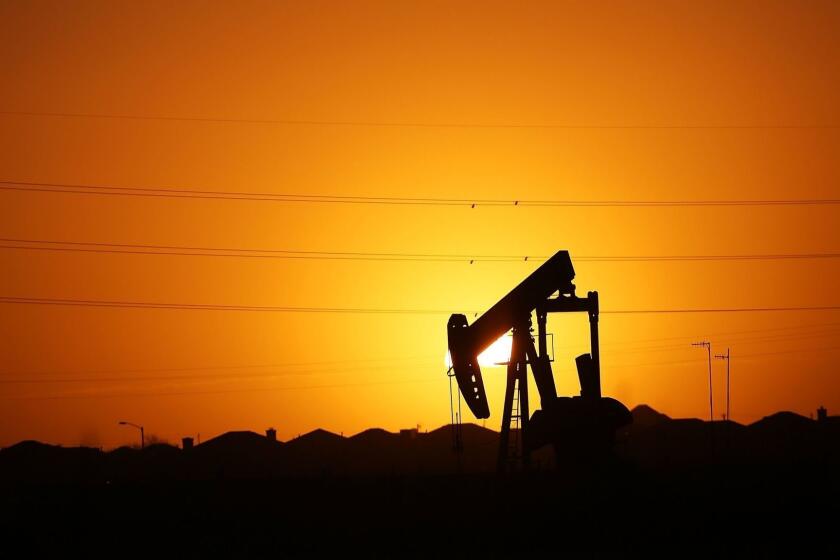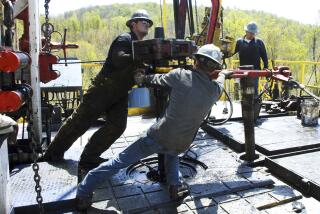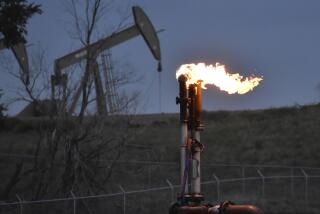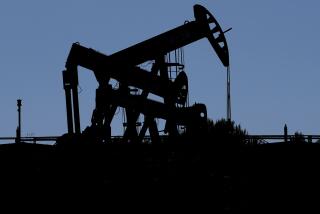Has the U.S. hit peak shale oil? Output has gone from explosive to sluggish
- Share via
America’s shale boom got the world accustomed to soaring production. Now growth has slowed, and a cloud has formed over the industry.
Fracking pushed the U.S. closer to its long-sought goal of energy independence at a time of unprecedented geopolitical risk. Wells from Texas’ Permian Basin to the Bakken in North Dakota turned farmers and ranchers into overnight millionaires. Drivers enjoyed cheap gasoline, decent-paying jobs sprang up in small towns and new technology attracted investment from all corners of the world, keeping drillers busy.
It’s true that the end of the boom has been foretold before. For years, the good times came with the warning that a litany of financial and engineering issues would doom the revolution. Such naysaying was proved wrong again and again by the industry’s resilience. Producers were able to borrow cheaply, fine-tune operations and trim costs along their supply chains.
But the tea leaves look different this year. Money isn’t as plentiful for an industry that in the last decade burned through nearly $200 billion. Investors are restless. Returns haven’t matched rocketing production, with the S&P 500 Oil & Gas Exploration stock index losing 21% in the last 10 years, compared with a 177% rise in the wider market.
“I don’t think the call for the end of shale is stronger this year,” said Ed Morse, global head of commodities research at Citigroup Global Markets Inc. “But it’s more detailed.”
Jerry Morales, the mayor of Midland, Texas, and a local restaurateur, is being whipsawed by the latest Permian Basin shale-oil boom.
Production growth has run at a pace of roughly 3% this year after gaining nearly 21% from 2017 to 2018, according to numbers from the U.S. Energy Information Administration. Estimates for 2020 vary, but even the most optimistic forecaster has the percentage change nowhere near like it was in the glory days, causing even the cowboy-booted wildcatters who ignited the revolution to express doubts.
“You’re going to see a significant fallback in Permian growth,” Scott Sheffield, chief executive of Pioneer Natural Resources Co., told analysts in an August call. “You’ll probably move toward no growth for most people.”
Since the oil-price bust of 2014, unpredictability has been the theme music of U.S. shale. But through all the down moments — a wave of bankruptcies and a drop in the number of drilling rigs among them — production has proved durable. It grew by more than 2 million barrels per day last year, for example.
But 2019 has played a different tune. Even with prices holding steady above $52 a barrel, oil output was virtually unchanged at 12 million barrels a day in the first seven months, according to the EIA. In weekly data available since July, production has hovered at about 12.4 million barrels per day.
Some traders and analysts remain upbeat, suggesting that the slowdown is a result of events like bad weather. They said new pipelines ramping up will expand takeaway capacity and help drive output gains in 2020. Two of the biggest U.S. oil companies are expanding in the shale patch.
But investors have had enough. They’re demanding companies spend less and pay more dividends. Activists are forcing companies to put themselves up for sale. Bank funding is getting tighter, too, according to a Federal Reserve Bank of Dallas survey.
Access to capital is especially vital to shale drillers because of the wells’ rapid decline rates. Fracking production falls as much as 70% in the first year, compared with as little as 5% from conventional vertical drilling, meaning new wells are constantly needed. Once the cash for drilling dries up, production quickly follows.
A more existential issue is also at play. Frackers in the Permian, the largest U.S. shale patch, are packing oil wells closer together because they’re running out of space. That creates a loss of well pressure, a phenomenon known as the parent-child effect. It could lead to a loss of 15% to 20% of recoverable crude, according to Houston-based investment bank Tudor, Pickering, Holt & Co., and an overall production decline of 1 million barrels per day, Sanford C. Bernstein analyst Bob Brackett said in a note.
In July, Concho Resources Inc. revealed disastrous results of a Permian spacing test. The stock dropped 22% in one day. That was followed by indications from Apache Corp. and Whiting Petroleum Corp. that they were also experiencing delays that hurt production.
At the moment, forecasters see different outcomes for 2020, but they’re united that growth will be sluggish. The EIA predicted that next year’s production will expand by nearly 1 million barrels a day — half of 2018 growth.
Pioneer said oil output will grow at about 600,000 to 700,000 barrels per day on average over the next few years.
It’s all to do with “the change in investor mindset,” CEO Sheffield said at a recent conference. “That’s probably taken off about 300,000 barrels of oil a day off the marketplace going forward.”
S&P Global Platts Analytics said that 2020 production is likely to expand at 1.1 million barrels, while Wood Mackenzie estimates growth at roughly half that level.
Macquarie Group Ltd.’s number is about 1.3 million barrels per day, assuming the price holds near $55 a barrel, but cautioned the estimate could be drastically reduced if the rig count doesn’t increase after recently dropping to a two-year low.
Giants like Exxon Mobil Corp. and Chevron Corp. have plans to expand in the Permian Basin. Unencumbered by the funding problems faced by independent producers, they plan to more than double production by the early 2020s.
For now, though, the gathering clouds have dimmed the outlook. Through August, the industry has completed 11% more wells than last year, according to David Ramsden-Wood, chief operating officer for Franklin Mountain Energy.
Even with the added drilling, he said, production hasn’t grown at all.
More to Read
Inside the business of entertainment
The Wide Shot brings you news, analysis and insights on everything from streaming wars to production — and what it all means for the future.
You may occasionally receive promotional content from the Los Angeles Times.











